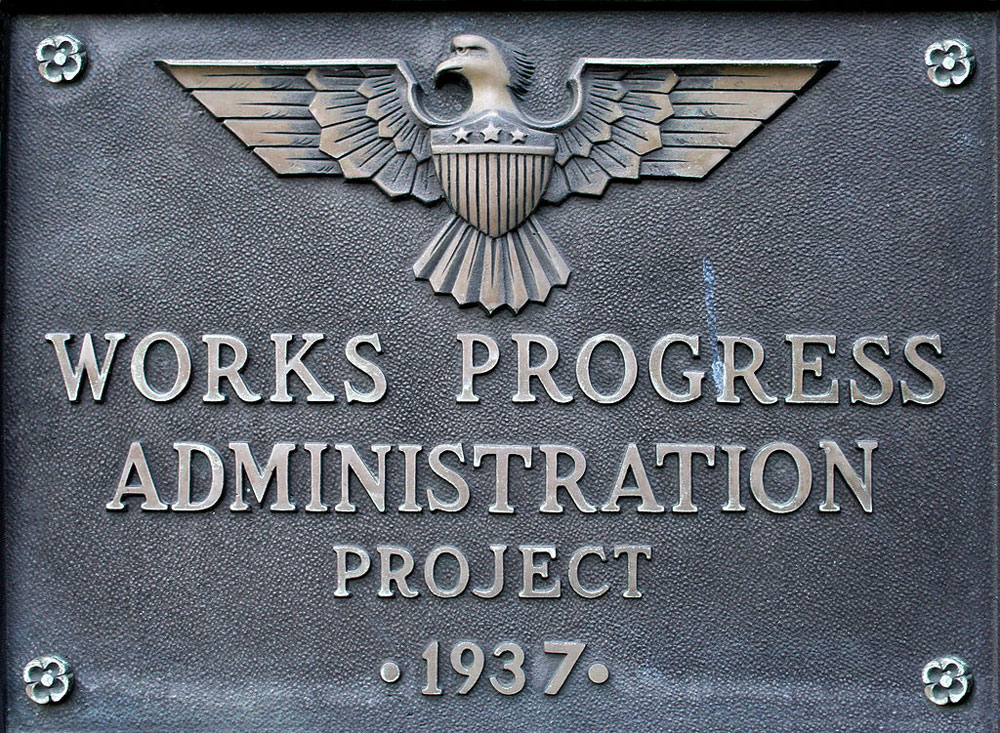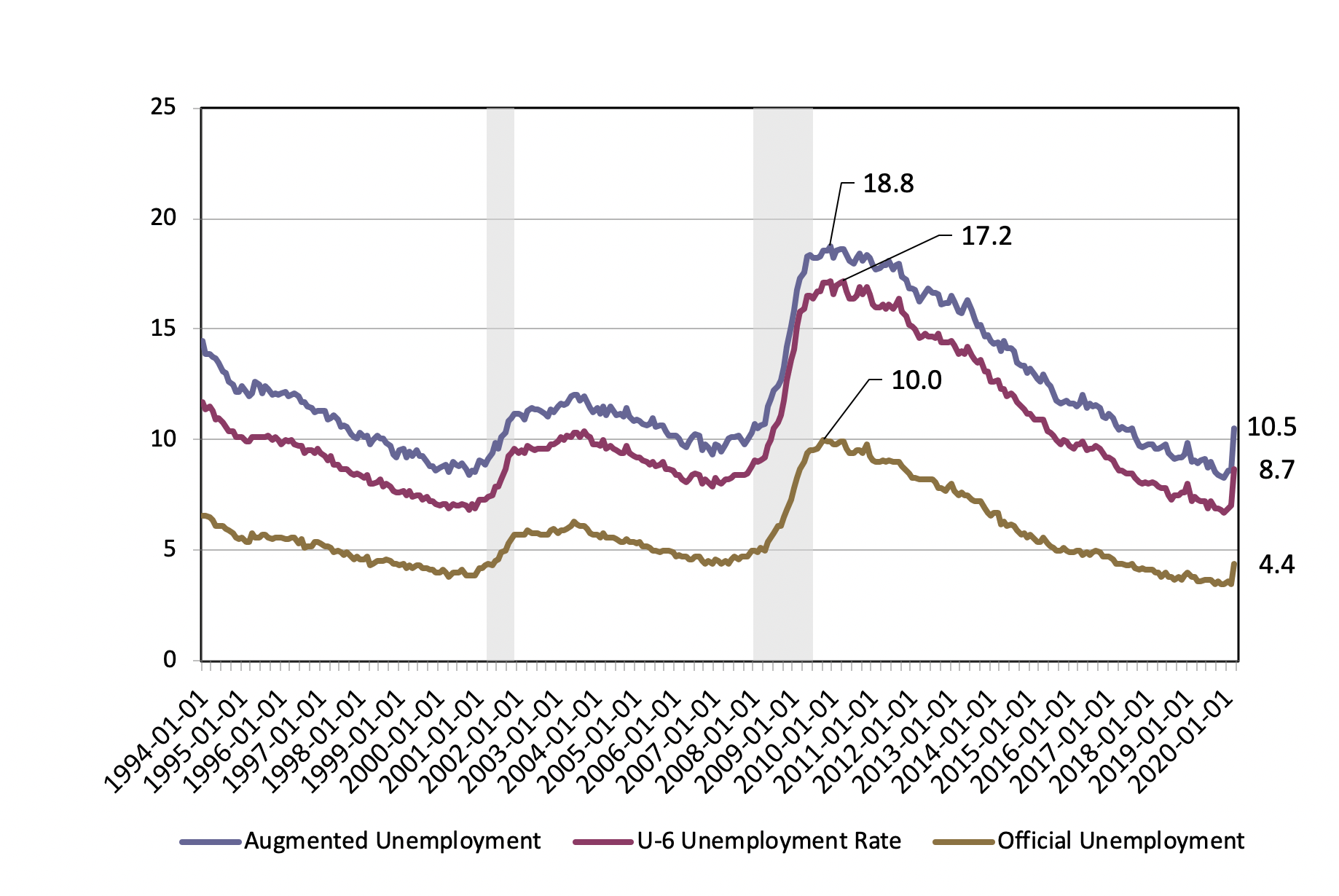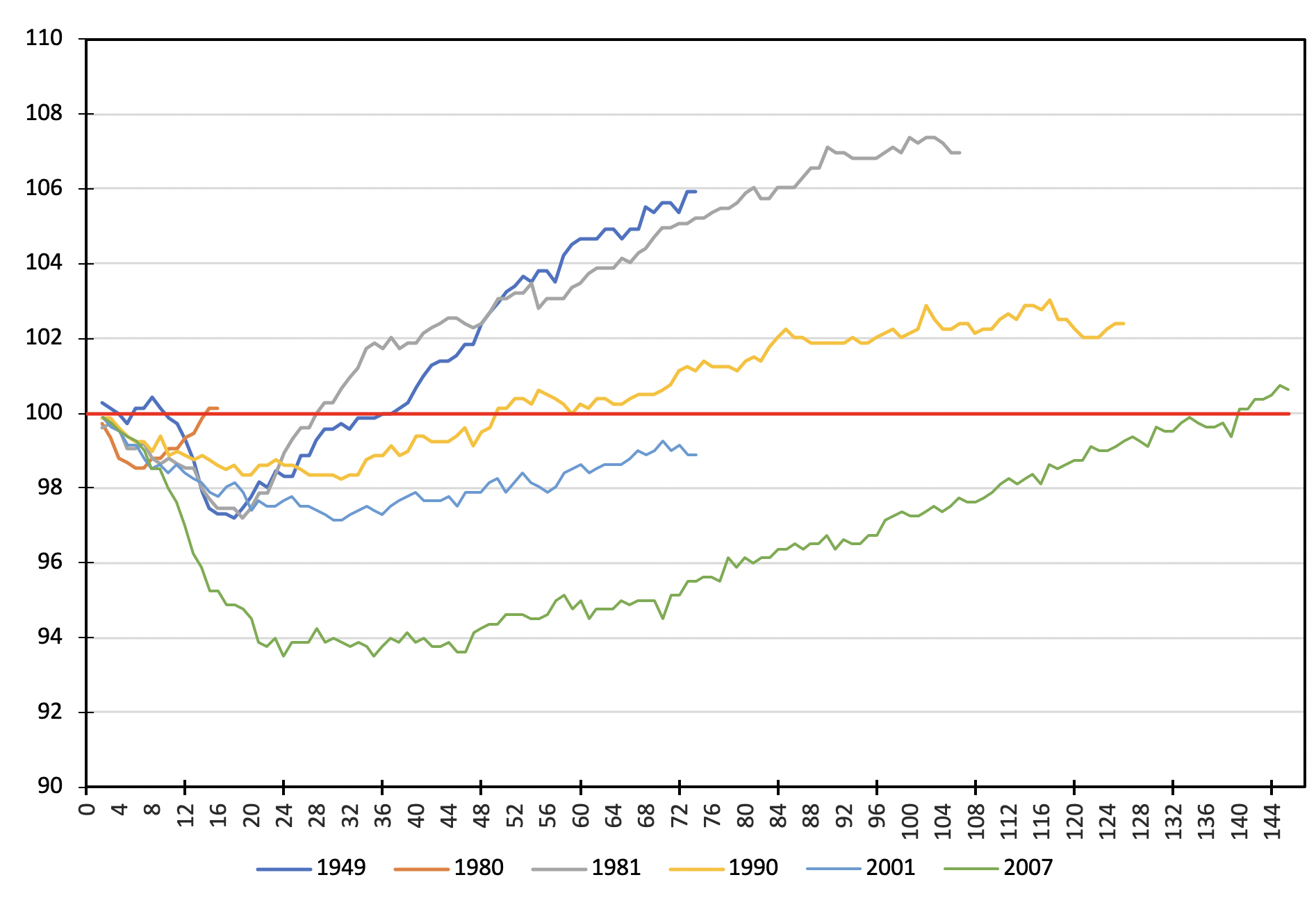
Editor’s Note: We run this article on a day when it was reported that, in the past month, a total of 20.5 million Americans lost their jobs, more than 10 times the previous record. Unemployment climbed in one month from 4.4 to 14.7 percent. The more inclusive U-6 measure (discussed in this article) increased even more—from 8.7 to 22.8 percent. We must do better than this.
How long will the current economic downturn last? With over 30 million Americans (or more) newly out of work, and hundreds of millions more worldwide, this question has to be on many people’s minds, whatever your place in the economy.
Discussion has abounded as to whether the economic recovery might take the shape of a V (quick recovery), U (long recession), L (very long recession or depression), or W (double-dip recession).
But the economy is not just a fact of nature. It depends, crucially, on policy choice. Typically, the US has not made the best policy choices. The Great Recession is a clear and memorable example of an instance where policy choices made a bad economic situation far worse. But we need not make the same mistakes this time. Indeed, as we outline below, a much better path forward is available to us.
Let’s start with a quick review of the numbers. As we know, over 30 million Americans have filed for unemployment benefits, yet many more who are eligible have yet to be able to sign up at overwhelmed state unemployment insurance offices. On April 30th, the US Department of Labor (DOL) announced that the insured unemployment rate, which measures the percentage of people receiving unemployment insurance over the labor force, had achieved its highest record in history at 12.4 percent. In states like Michigan and Connecticut, these rates were as high as 21 percent.
Of course, these figures are lagging and imperfect measures of the true devasting consequences of COVID-19 to American workers and their families. A large portion of the unemployed will not be eligible for unemployment insurance, even under the more “inclusive” criteria established by the CARES Act. We are far from realizing the full extent of the economic losses.
Our fear is that even once the economy begins to recover, employment will lag as it did after the Great Recession. The U-6 unemployment measure includes those marginally attached—that is, people who want work and have sought employment in the past year but not in the previous four weeks—plus involuntary part-time workers. This is a truer measure of unemployment. While official unemployment peaked at 10 percent in the Great Recession, the U-6 measure reached a peak of 17.2 percent in April 2010, and only started a downward trend in October 2011.
Figure 1. Unemployment Rates in Recovery

The above graph shows that it took until November 2017 for the U-6 measure to return to eight percent. We include our own measure of “augmented unemployment,” which adds to the U-6 measure all those not in the labor force who wanted a job but did not search for one in the previous year. Our augmented measure only returned to pre-recession levels in June 2018. Note that by our measure, we had 14.4 million potential workers who were at least partially idled before the COVID-19 crisis hit—even as many pundits were proclaiming this to be as good as it gets. We could easily have three times that many idled by this summer.
As we begin to recover from the pandemic, some workers will be rehired as non-essential businesses are allowed to reopen, but others could continue to lose their jobs due to the severe contraction in demand that will persist even after the supply shock ends. It is likely that many will join the ranks of the long-term unemployed. For the sake of comparison, following the Great Recession, the percentage of the unemployed who were out of a job for 27 weeks or more reached its historical peak of 45.2 percent only in September 2011. The current downturn is also likely to create a problem of long-term unemployment.
More troubling, if recovery follows a similar pattern to that of the last recession, even as unemployment rates begin to fall, labor force participation and the employment-population ratio will remain depressed for an extended period. Figure 2 shows that recovery of the prime-age (those aged 25–54 years, who always have the highest labor force participation rates) employment-population ratio is increasingly sluggish after each recession. After the Great Recession, it took 141 months for it to return to its pre-recessionary level.
Figure 2. Age 25–54: Employment-Ratio Recovery (# months)

The pattern of recent decades is that with each recession, more people become excluded—more or less permanently—from labor markets. This trend is particularly worrisome for 25-to-54-year-old men, who have been leaving the labor force since 1970, presumably as job prospects dimmed. For almost 40 years, rising labor force participation rates of women made up for that. However, as Figure 3 shows, the overall labor force participation rate fell off in the Great Recession and only very slowly recovered over the next two decades. (See Dantas and Wray, 2017). It is probable that the current employment crisis will also have long-lasting impacts, especially on prime-age male labor force participation rates.
Figure 3. Age 25–54, Labor Force Participation Rate (LFPR), Male vs. Female (Jan 1970–Mar 2020)

The US does not fare well in international comparisons; in 2018, it had one of the lowest rates of prime-age labor force participation among OECD countries. It is hard to make the argument that excessive labor market regulation or generous social safety nets are the reason for the lower participation rates in the US, since OECD countries with higher labor force participation tend to have more regulated labor markets and more extensive and comprehensive social safety nets.
Further, the US Congress passed “welfare reform” in 1996, which curtailed or imposed time limits on government assistance to those in need to promote work over government-dependency of the able-bodied. Still, performance as compared to other OECD countries actually declined (see Dantas and Wray, 2017). The US was among only a handful of countries with a falling participation ratio between 1990 and 2018.
While today’s crisis is affecting supply and demand simultaneously, once the pandemic is resolved and the economy starts to reopen, without significant demand-side stimulus, demand may remain subdued for years to come, resulting in long-term unemployment. It took years of falling unemployment rates and economic expansion for prime-age labor force participation to recover. With reduced opportunities to participate in the labor force, wages will fall, poverty rates may reach record levels, and economic insecurity and despair will add to the social chaos, even after the health distress has been resolved. While we’ve seen some attempts to prop up demand with the CARES Act, we are still losing millions of jobs a week.
Sign up for our free newsletters
Subscribe to NPQ's newsletters to have our top stories delivered directly to your inbox.
By signing up, you agree to our privacy policy and terms of use, and to receive messages from NPQ and our partners.
Is there a better way to deal with soaring unemployment and economic insecurity? History is our best guide. Direct job creation was a fundamental component of the New Deal. History shows that it was not extensive enough, and that people of color were often excluded. And, of course, many New Deal jobs programs were abandoned once the economy recovered. This time, we can make a new New Deal jobs program—one more generous, inclusive, and permanent. In particular, a permanent Job Guarantee program can tap into American creativity, unleashing the productive capacities. (See Wray et al, 2018 for an illustration of how the program could be structured.)
For our purposes, let’s call this policy a Public Service Employment guarantee, or PSE for short. With a PSE guarantee in place, the federal government would take over payrolls for all workers laid off and furloughed, as well as offer jobs to those already unemployed or who have been largely left behind by the rescue packages adopted so far.
The jobs would pay a basic wage of $15 per hour plus benefits (healthcare, childcare, and in high-rent areas a supplemental housing allowance). Workers would be placed on payroll immediately, as soon as they sign up. They would then gradually be matched to job openings. Nonprofits, as well as public agencies, would be eligible to submit proposals to offer projects that provide safe work to help with the crisis and recovery. As recovery begins, firms can begin to hire workers back into the private sector, and state and local governments can hire workers back into regular public sector jobs.
There are several advantages to such an approach.
- First, the spending is targeted to those who need jobs, rather than mailing out checks to many who do not. As we now understand, the pandemic has targeted much of its destruction at people of color or those otherwise disadvantaged: homeless, unemployed, poor, and low-wage service sector and “gig” workers. Those with higher education, more wealth, and greater income are far more likely to have retained their jobs while working from home.
- Second, the PSE program can be used to supply workers to needed relief projects—such as packaging meals for isolated, elderly, and sick individuals. Of course, these workers must be protected, so the jobs have to be designed with safety in mind.
- Third, the PSE program will provide workers as we phase in Green New Deal (See Nersisyan and Wray, 2019.)
- Fourth, the PSE will be permanent. As we’ve shown, recoveries take a long time to regain jobs and they always leave many behind. Even a decade after the Great Recession we had not fully recovered. In many ways, our society and economy were weaker than they had been in 2007, which is one of the reasons why the contemporary US response to the pandemic has been so blatantly inadequate.
The PSE will provide jobs for those who will be left behind this time and will continue to provide a jobs safety net for anyone who needs it. We estimate that even at a business cycle peak, the PSE would employ as many as 10 million. Obviously, this is only an educated guess. But even if it turned out to be an overestimate, that would simply mean that the private sector was able to hire more workers out of the PSE program than we have expected. That’s a good thing! The PSE will expand whenever the economy slows and shrink whenever the economy expands. It is an automatic stabilizer and a social safety net—by design.
We must insist that we are not going back to “normal.” In large part, the pandemic itself was the inevitable consequence of neoliberal policies applied over the past half century. As Naomi Klein (2019) has convincingly demonstrated, economic elites regularly use crises as an opportunities to apply what she calls the “shock doctrine” to achieve their goals. This time must be different: progressives must tackle the challenges society faces.
The COVID-19 related health crisis will eventually end, but even when it does, if we don’t change our outlook and approach, we’ll still face the same problems we had before the crisis: a lack of adequate access to health care, an environmental crisis, an economic crisis, an inequality crisis, and a poverty crisis, as well as social and political crises to resolve. The PSE is part of a broader shift that we will need to repair ourselves from the unsustainable economy we had before.
The good news is that—with imagination, creativity, and persistence—we have the chance to build the just economy and society that we deserve.
References
Dantas, F., and L. R. Wray. 2017. “Full Employment: Are We There Yet?” Public Policy Brief No. 142. Annandale-on-Hudson, NY: Levy Economics Institute of Bard College. February.
OECD (Organisation for Economic Co-operation and Development). 2020. “Labor Force Participation Rate (Indicator).” OECD Data. Available at: https://doi: 10.1787/8a801325-en. Last accessed May 4, 2020.
Klein, N. 2019. “On Fire: The Burning Case for a Green New Deal.” New York, NY: Simon & Schuster.
Nersisyan, Y. and L.R. Wray. 2020. “Can We Afford the Green New Deal?”, Public Policy Brief No. 148. Annandale-on- Hudson, NY: Levy Economics Institute of Bard College. January.
Wray, L. R., F. Dantas, S. Fullwiler, P. R. Tcherneva, and S. A. Kelton. 2018. “Public Service Employment: A Path to Full Employment.” Research Project Report. Annandale-on- Hudson, NY: Levy Economics Institute of Bard College. April.










